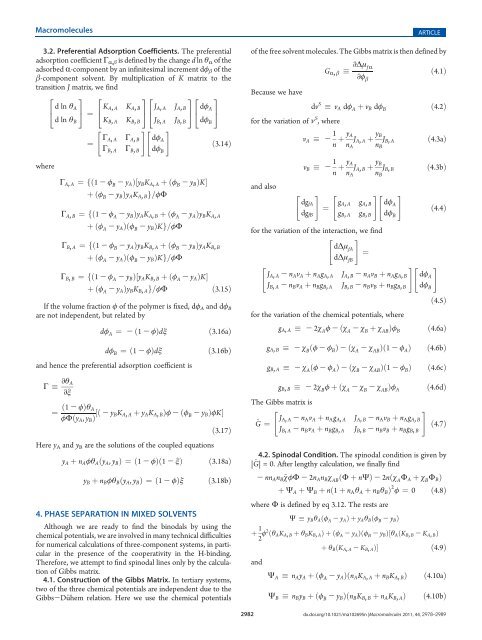Preferential Adsorption and Co-nonsolvency of ... - au one net
Preferential Adsorption and Co-nonsolvency of ... - au one net
Preferential Adsorption and Co-nonsolvency of ... - au one net
Create successful ePaper yourself
Turn your PDF publications into a flip-book with our unique Google optimized e-Paper software.
Macromolecules ARTICLE<br />
3.2. <strong>Preferential</strong> <strong>Adsorption</strong> <strong>Co</strong>efficients. The preferential<br />
adsorption coefficient ΓR,β is defined by the change d ln θR <strong>of</strong> the<br />
adsorbed R-comp<strong>one</strong>nt by an infinitesimal increment dφβ <strong>of</strong> the<br />
β-comp<strong>one</strong>nt solvent. By multiplication <strong>of</strong> K matrix to the<br />
transition J matrix, we find<br />
2 3<br />
dlnθA<br />
4 5 ¼<br />
dlnθB<br />
KA,<br />
2 3<br />
A KA, B<br />
4 5<br />
KB, A KB, B<br />
JA,<br />
2 3<br />
A JA, B<br />
4 5<br />
JB, A JB, B<br />
dφ 2 3<br />
A<br />
4 5<br />
dφB ¼ ΓA,<br />
" # " #<br />
A ΓA, B dφA<br />
ð3.14Þ<br />
ΓB, A ΓB, B dφB where<br />
ΓA, A ¼fð1-φB- yAÞ½yBKA, A þðφB - yBÞKŠ<br />
þðφB - yBÞyAKA, Bg=φΦ<br />
ΓA, B ¼fð1 - φ A - yBÞyAKA, B þðφ A - yAÞyBKA, A<br />
þðφ A - yAÞðφ B - yBÞKg=φΦ<br />
ΓB, A ¼fð1 - φ B - yAÞyBKB, A þðφ B - yBÞyAKB, B<br />
þðφ A - yAÞðφ B - yBÞKg=φΦ<br />
ΓB, B ¼fð1-φA- yBÞ½yAKB, B þðφA - yAÞKŠ<br />
þðφA - yAÞyBKB, Ag=φΦ ð3.15Þ<br />
If the volume fraction φ <strong>of</strong> the polymer is fixed, dφ A <strong>and</strong> dφ B<br />
are not independent, but related by<br />
dφ A ¼ - ð1 - φÞdξ ð3.16aÞ<br />
dφB ¼ð1-φÞdξ ð3.16bÞ<br />
<strong>and</strong> hence the preferential adsorption coefficient is<br />
∂θA<br />
Γ<br />
∂ξ<br />
ð1 - φÞθA<br />
¼<br />
φΦðyA, yBÞ ½ð - yBKA, A þ yAKA, BÞφ - ðφB - yBÞφKŠ<br />
Here yA <strong>and</strong> yB are the solutions <strong>of</strong> the coupled equations<br />
ð3.17Þ<br />
yA þ nAφθAðyA, yBÞ ¼ð1 - φÞð1 - ξÞ ð3.18aÞ<br />
yB þ nBφθBðyA, yBÞ ¼ð1 - φÞξ ð3.18bÞ<br />
4. PHASE SEPARATION IN MIXED SOLVENTS<br />
Although we are ready to find the binodals by using the<br />
chemical potentials, we are involved in many technical difficulties<br />
for numerical calculations <strong>of</strong> three-comp<strong>one</strong>nt systems, in particular<br />
in the presence <strong>of</strong> the cooperativity in the H-binding.<br />
Therefore, we attempt to find spinodal lines only by the calculation<br />
<strong>of</strong> Gibbs matrix.<br />
4.1. <strong>Co</strong>nstruction <strong>of</strong> the Gibbs Matrix. In tertiary systems,<br />
two <strong>of</strong> the three chemical potentials are independent due to the<br />
Gibbs-D€uhem relation. Here we use the chemical potentials<br />
<strong>of</strong> the free solvent molecules. The Gibbs matrix is then defined by<br />
GR, β<br />
∂Δμ f R<br />
∂φ β<br />
Bec<strong>au</strong>se we have<br />
dv S<br />
vA dφA þ vB dφB for the variation <strong>of</strong> ν S , where<br />
<strong>and</strong> also<br />
vA<br />
vB<br />
- 1<br />
n<br />
- 1<br />
n<br />
þ yA<br />
nA<br />
þ yA<br />
nA<br />
JA, A þ yB<br />
JA, B þ yB<br />
JB, A<br />
nB<br />
JB, B<br />
nB<br />
" #<br />
dgfA<br />
¼<br />
dgfB<br />
gA,<br />
" # " #<br />
A gA, B dφA<br />
gB, A gB, B dφB ð4.1Þ<br />
ð4.2Þ<br />
ð4.3aÞ<br />
ð4.3bÞ<br />
ð4.4Þ<br />
for the variation <strong>of</strong> the interaction, we find<br />
" #<br />
dΔμfA ¼<br />
dΔμfB " # " #<br />
JA, A - nAvA þ nAgA, A JA, B - nAvB þ nAgA, B dφA<br />
JB, A - nBvA þ nBgB, A JB, B - nBvB þ nBgB, B dφB ð4.5Þ<br />
for the variation <strong>of</strong> the chemical potentials, where<br />
gA, A - 2χAφ - ðχA - χB þ χABÞφB ð4.6aÞ<br />
gA, B - χ B ðφ - φ BÞ - ðχ A - χ AB Þð1 - φ AÞ ð4.6bÞ<br />
gB, A - χ A ðφ - φ AÞ - ðχ B - χ AB Þð1 - φ BÞ ð4.6cÞ<br />
gB, B - 2χ B φ þðχ A - χ B - χ AB Þφ A ð4.6dÞ<br />
The Gibbs matrix is<br />
^G ¼ JA,<br />
"<br />
A - nAvA þ nAgA, A<br />
JB, A - nBvA þ nBgB, A<br />
#<br />
JA, B - nAvB þ nAgA, B<br />
JB, B - nBvB þ nBgB, B<br />
ð4.7Þ<br />
4.2. Spinodal <strong>Co</strong>ndition. The spinodal condition is given by<br />
|^G| = 0. After lengthy calculation, we finally find<br />
- nnAnB~χφΦ - 2nAnBχABðΦ þ nΨÞ - 2nðχAΦA þ χBΦBÞ þ ΨA þ ΨB þ nð1 þ nAθA þ nBθBÞ 2 φ ¼ 0 ð4.8Þ<br />
where Φ is defined by eq 3.12. The rests are<br />
Ψ yBθAðφA - yAÞþyAθBðφB - yBÞ<br />
þ 1<br />
2 φ2ðθAKA, B þ θBKB, AÞþðφA - yAÞðφB - yBÞ½θAðKB, B - KA, BÞ<br />
<strong>and</strong><br />
þ θBðKA, A - KB, AÞŠ ð4.9Þ<br />
ΨA nAyA þðφ A - yAÞðnAKA, A þ nBKA, BÞ ð4.10aÞ<br />
ΨB nByB þðφ B - yBÞðnBKB, B þ nAKB, AÞ ð4.10bÞ<br />
2982 dx.doi.org/10.1021/ma102695n |Macromolecules 2011, 44, 2978–2989












